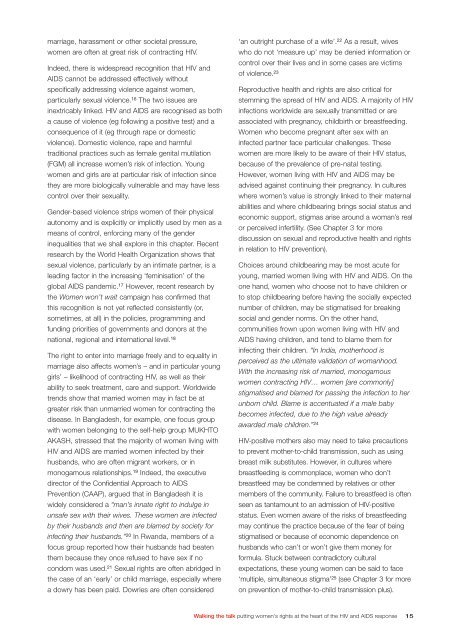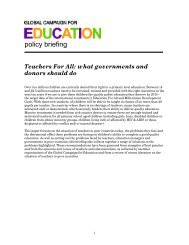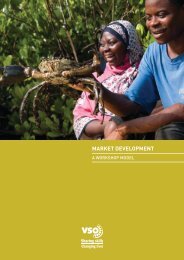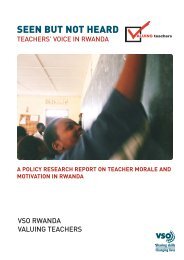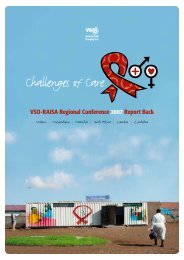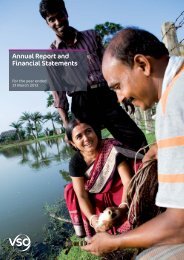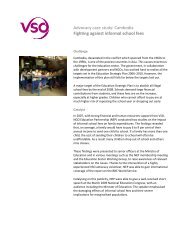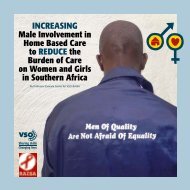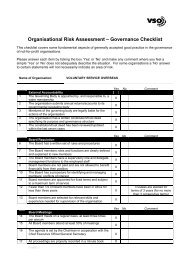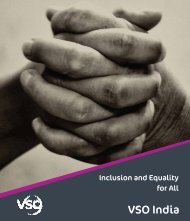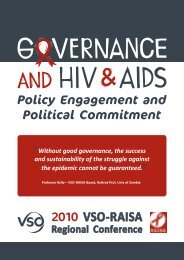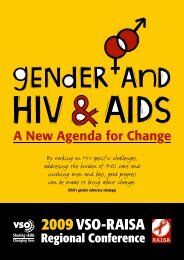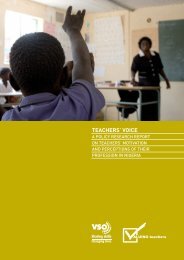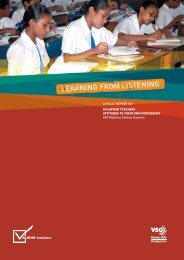Walking the Talk - VSO
Walking the Talk - VSO
Walking the Talk - VSO
Create successful ePaper yourself
Turn your PDF publications into a flip-book with our unique Google optimized e-Paper software.
marriage, harassment or o<strong>the</strong>r societal pressure,women are often at great risk of contracting HIV.Indeed, <strong>the</strong>re is widespread recognition that HIV andAIDS cannot be addressed effectively withoutspecifically addressing violence against women,particularly sexual violence. 16 The two issues areinextricably linked. HIV and AIDS are recognised as botha cause of violence (eg following a positive test) and aconsequence of it (eg through rape or domesticviolence). Domestic violence, rape and harmfultraditional practices such as female genital mutilation(FGM) all increase women’s risk of infection. Youngwomen and girls are at particular risk of infection since<strong>the</strong>y are more biologically vulnerable and may have lesscontrol over <strong>the</strong>ir sexuality.Gender-based violence strips women of <strong>the</strong>ir physicalautonomy and is explicitly or implicitly used by men as ameans of control, enforcing many of <strong>the</strong> genderinequalities that we shall explore in this chapter. Recentresearch by <strong>the</strong> World Health Organization shows thatsexual violence, particularly by an intimate partner, is aleading factor in <strong>the</strong> increasing ‘feminisation’ of <strong>the</strong>global AIDS pandemic. 17 However, recent research by<strong>the</strong> Women won’t wait campaign has confirmed thatthis recognition is not yet reflected consistently (or,sometimes, at all) in <strong>the</strong> policies, programming andfunding priorities of governments and donors at <strong>the</strong>national, regional and international level. 18The right to enter into marriage freely and to equality inmarriage also affects women’s – and in particular younggirls’ – likelihood of contracting HIV, as well as <strong>the</strong>irability to seek treatment, care and support. Worldwidetrends show that married women may in fact be atgreater risk than unmarried women for contracting <strong>the</strong>disease. In Bangladesh, for example, one focus groupwith women belonging to <strong>the</strong> self-help group MUKHTOAKASH, stressed that <strong>the</strong> majority of women living withHIV and AIDS are married women infected by <strong>the</strong>irhusbands, who are often migrant workers, or inmonogamous relationships. 19 Indeed, <strong>the</strong> executivedirector of <strong>the</strong> Confidential Approach to AIDSPrevention (CAAP), argued that in Bangladesh it iswidely considered a “man’s innate right to indulge inunsafe sex with <strong>the</strong>ir wives. These women are infectedby <strong>the</strong>ir husbands and <strong>the</strong>n are blamed by society forinfecting <strong>the</strong>ir husbands.” 20 In Rwanda, members of afocus group reported how <strong>the</strong>ir husbands had beaten<strong>the</strong>m because <strong>the</strong>y once refused to have sex if nocondom was used. 21 Sexual rights are often abridged in<strong>the</strong> case of an ‘early’ or child marriage, especially wherea dowry has been paid. Dowries are often considered‘an outright purchase of a wife’. 22 As a result, wiveswho do not ‘measure up’ may be denied information orcontrol over <strong>the</strong>ir lives and in some cases are victimsof violence. 23Reproductive health and rights are also critical forstemming <strong>the</strong> spread of HIV and AIDS. A majority of HIVinfections worldwide are sexually transmitted or areassociated with pregnancy, childbirth or breastfeeding.Women who become pregnant after sex with aninfected partner face particular challenges. Thesewomen are more likely to be aware of <strong>the</strong>ir HIV status,because of <strong>the</strong> prevalence of pre-natal testing.However, women living with HIV and AIDS may beadvised against continuing <strong>the</strong>ir pregnancy. In cultureswhere women’s value is strongly linked to <strong>the</strong>ir maternalabilities and where childbearing brings social status andeconomic support, stigmas arise around a woman’s realor perceived infertility. (See Chapter 3 for morediscussion on sexual and reproductive health and rightsin relation to HIV prevention).Choices around childbearing may be most acute foryoung, married women living with HIV and AIDS. On <strong>the</strong>one hand, women who choose not to have children orto stop childbearing before having <strong>the</strong> socially expectednumber of children, may be stigmatised for breakingsocial and gender norms. On <strong>the</strong> o<strong>the</strong>r hand,communities frown upon women living with HIV andAIDS having children, and tend to blame <strong>the</strong>m forinfecting <strong>the</strong>ir children. “In India, mo<strong>the</strong>rhood isperceived as <strong>the</strong> ultimate validation of womanhood.With <strong>the</strong> increasing risk of married, monogamouswomen contracting HIV… women [are commonly]stigmatised and blamed for passing <strong>the</strong> infection to herunborn child. Blame is accentuated if a male babybecomes infected, due to <strong>the</strong> high value alreadyawarded male children.” 24HIV-positive mo<strong>the</strong>rs also may need to take precautionsto prevent mo<strong>the</strong>r-to-child transmission, such as usingbreast milk substitutes. However, in cultures wherebreastfeeding is commonplace, women who don’tbreastfeed may be condemned by relatives or o<strong>the</strong>rmembers of <strong>the</strong> community. Failure to breastfeed is oftenseen as tantamount to an admission of HIV-positivestatus. Even women aware of <strong>the</strong> risks of breastfeedingmay continue <strong>the</strong> practice because of <strong>the</strong> fear of beingstigmatised or because of economic dependence onhusbands who can’t or won’t give <strong>the</strong>m money forformula. Stuck between contradictory culturalexpectations, <strong>the</strong>se young women can be said to face‘multiple, simultaneous stigma’ 25 (see Chapter 3 for moreon prevention of mo<strong>the</strong>r-to-child transmission plus).<strong>Walking</strong> <strong>the</strong> talk putting women's rights at <strong>the</strong> heart of <strong>the</strong> HIV and AIDS response 15


